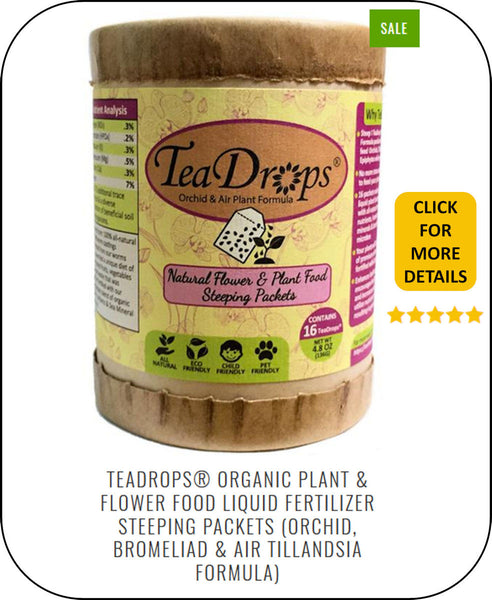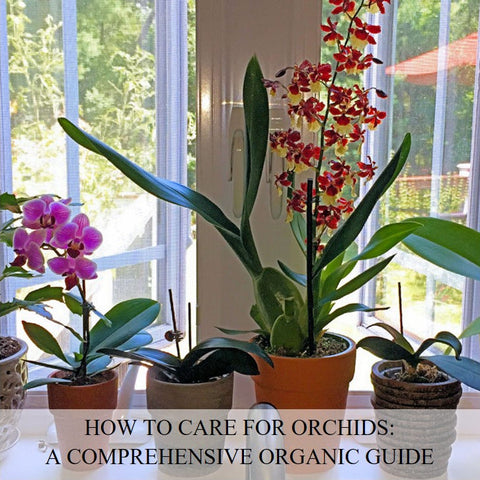Your Cart is Empty
FREE U.S. SHIPPING / NEW CUSTOMER 10% OFF, Use ECOLOVE

How to care for Orchids the Earthworm Technologies way will be the topic for discussion this time! In other words EASILY AND ORGANICALLY because after all that is one of our mantras!
If you’ve been following us for a while or bought our organic gardening plant food products you know that we like to interact with our customers as well as other gardeners, writers and pretty much anyone interested in gardening. This past season we were asked lots of various gardening questions while mingling with our customers at garden shows, farmers markets, on social media and online but one topic that seemed to come up over and over was of course, one of our favorite flowering houseplants and most likely one of yours as well…ORCHIDS!
We’ve received every question in the book on how to care for Orchids ranging from how to grow Orchids, how to repot an Orchid, how to water Orchids down to the proper Orchid food to use (that one’s easy…our TeaDrops Orchid, Bromeliad & Tillandsia (Air Plant) organic plant fertilizer works perfectly as an Orchid Fertilizer for regular feeding throughout the year, but we’ll get into why later).
So, we decided it’s time to write our first Plant Care Blog Series and the guest of honor is Orchids! We will be writing a comprehensive How To Care For Orchids 101 course with various sections to be added as time goes on (we’ll post a new article every week, so don’t forget to sign up for our blog newsletter at the bottom of this page so you’ll be notified when the next section gets posted).
Now on to the introduction…
Orchids are one of our favorite flowering plants (although to be honest, with over 60 kinds of houseplants in our repertoire you might be hearing “favorite” a lot in upcoming articles :). We have found over the years that a mere mention of the word “Orchid” gets people excited because the flowers are so gorgeous but is immediately followed by an “oh boy, I can never get those plants to grow.”
It can be an intimidating flower to keep in the house but it doesn’t have to be so! Our philosophy has always been to understand the underlying root (pun intended) of a subject to fully understand how to maximize its potential. We do this when creating our organic plant fertilizer and we also do it when growing all the varieties of plants and flowers we have in the Earthworm Technologies’ gardens. Orchids are no different and we’re going to explain it to you as easy as possible so you can grow these gorgeous perennials yourself for years to come.
is that they make up quite an expansive family of plants that have thousands of different species not to mention thousands of hybrids. You may have come across some of more popular varieties of Orchids before (especially if you’ve gone to a Botanical Garden or attended an Orchid Garden Show).
Some of these types include Catleya, Dendrobium, Epidendrum and of course who doesn’t know the Phalaenopsis Orchid? Most of you will be familiar with the Phalaenopsis Orchids because these are the typical “go-to” Orchids you’ll find in your local grocery stores and garden nurseries. Phalaenopsis Orchids are also most commonly known as Moth Orchids!
is they can be either terrestrial or epiphytic. This distinction marks a VERY BIG difference in how you should care for your Orchid.
Terrestrials (stemming from the root Terra meaning of the Earth) are commonly plants that grow ON OR IN the earth. These types of plants are what we’re all most used to growing. Picture any flower or plant you grow in the soil from African Violets to Coleus plants to tomatoes, etc.
Epiphytes, on the other hand, are plants that grow ON other plants and capture their needs from things outside of the earth (for example from the air, outside elements and natural sediments and nutrients around).
Ephiphyte root zones tend to be looser and free-flowing. You might be surprised that Epiphytes contains quite a few plants beside Orchids that you’ve probably heard of before. For example, Christmas Cacti, some Ferns, some Mosses, Bromeliads (which also include Tillandsia also known as Air Plants which have become so popular especially on Pinterest :) (side note: an ephiphyte doesn’t mean the plant is feeding on or has a parasitic relationship with its host plant, it’s simply living physically on another plant).
Most of the Orchids we’ll discuss in this how to care for orchids blog series as well as the ones mentioned earlier fall under this Ephiphyte category and the distinction here is what we need to remember when we start discussing how to take care of Orchids especially when it comes to using the proper potting medium, providing ideal watering needs and feeding with optimal nutritional plant food.

To start you off, here are some How To Care For Orchids Quick Tips (we’ll get into the details of all of these points later in the series):



Repotting Orchids is an important task you want to learn because sooner or later you will find that your Orchid isn't looking so well or worse, has stopped blooming. As we mentioned in our introduction to our Orchid Care 101 Guide, caring for Orchids over the years can be a tricky and sometimes intimidating task but once you get to know the nuances of your Orchid, you'l...
Vermicompost (composted wood or food waste mixed with worm castings) & worm castings (defined as pure worm castings refined to 1/8" of an inch and much more concentrated & beneficial than vermicompost in the organic gard...